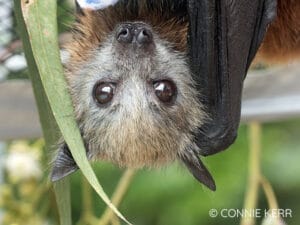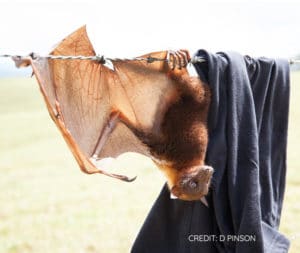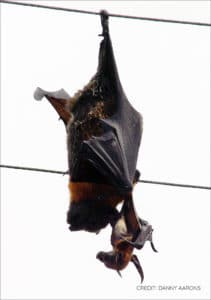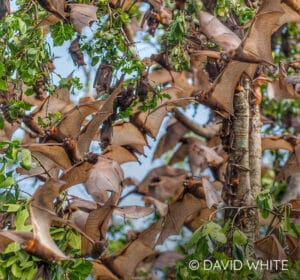Hazards
HAZARDS TO
FLYING-FOXES
Other than natural predation, weather extremes and food shortages, the most common hazards that affect bats in S.E. Queensland are outlined below.
Backyard
Entanglement in fruit tree netting
 Fruit tree netting, particularly ‘bird netting’ which has a mesh size greater than 1cm square, thrown loosely over a fruiting tree is a dangerous trap for all nocturnal wildlife. Flying-foxes in particular can get tangled very quickly. Once caught, they often suffer cruel and extensive injuries or death, depending on how long and how badly the bat has been entangled.
Fruit tree netting, particularly ‘bird netting’ which has a mesh size greater than 1cm square, thrown loosely over a fruiting tree is a dangerous trap for all nocturnal wildlife. Flying-foxes in particular can get tangled very quickly. Once caught, they often suffer cruel and extensive injuries or death, depending on how long and how badly the bat has been entangled.
Mother flying-foxes can be tempted by the lure of an easy meal in a backyard fruit tree. This often results in either mother, baby, or both becoming entangled in netting.
Use only white densely woven netting that passes the ‘finger test’ (netting that you cannot poke your finger through). Fruit Saver nets are recommended for small to medium sized trees. Hail Guard and Vege Net is suitable for use on larger trees.
Instructional videos on how to net your trees in a wildlife friendly way can be found at www.wildlifefriendlyfencing.com
Dog & Cat Attacks
Many suburban rescues involve bat encounters with cats and dogs. A large number of flying-foxes are killed or severely injured each year by domestic dogs. Dogs may be bitten or scratched and require veterinary attention and post-exposure vaccination.
Keep your pets inside at night, or in an area away from low hanging fruiting and flowering trees or shrubs. This allows flying-foxes, and other nocturnal wildlife, to feed in safety. This also ensures that your pet will not be bitten and require veterinary attention.
Swimming Pools
Flying-foxes can sometimes end up in backyard pools. Ensuring that there is an object in the pool that wildlife can climb on to as a refuge, or a rope dangling down from the edge facilitates escape and prevents possible drowning.
Cocos Palm (or Queen Palm)
 This South American palm (Syagrus romanzoffiana) has been a popular ornamental addition to gardens for its fast growth and tropical look. It is now widely regarded as invasive and undesirable due to its rapid spread and its harmful effect on many species of wildlife, including flying-foxes.
This South American palm (Syagrus romanzoffiana) has been a popular ornamental addition to gardens for its fast growth and tropical look. It is now widely regarded as invasive and undesirable due to its rapid spread and its harmful effect on many species of wildlife, including flying-foxes.
When natural food sources are scarce, flying-foxes will eat the seeds of the Cocos Palm. Through their seed dispersal activities, flying-foxes contribute to the spread of Cocos Palms into parks and bushland. This creates an ongoing issue for Councils.
By replacing Cocos Palms with Bangalow or Alexander Palms, native birds, bees and flying-foxes will benefit from the blossoms.
Cocos palms can affect Flying-foxes in the following ways:
- Poisoning when seeds are eaten green in times of hunger (September to January). Unripe seeds are toxic to flying-foxes. Dogs can also be affected by the toxins.
- Sticky fruits can cause severe constipation causing dehydration and death in young flying-foxes
- Toes caught in flower sheath causing self-mutilation and death
- Whole body or body parts caught in leaves that are easily shredded by claws creating a ‘cocoon’ effect around the bat causing stress and death if not physically removed.
- Juvenile animals can get seeds lodged behind their teeth causing a slow death from starvation
- Premature wearing of teeth due to the hard seed. Flying-Foxes have been known to live for 30 years in captivity but wild flying-foxes who appear young are now presenting with worn, missing or even no teeth.
Abandoned Baby
 Occasionally a baby flying-fox is found by itself on a bush or tree, or on the ground, crying out in distress. Flying-fox mothers will often return to a location for several consecutive nights searching for their young one if it was dropped accidentally. There are sometimes opportunities to reunite them, especially if the mother is heard in the area calling out to her young one.
Occasionally a baby flying-fox is found by itself on a bush or tree, or on the ground, crying out in distress. Flying-fox mothers will often return to a location for several consecutive nights searching for their young one if it was dropped accidentally. There are sometimes opportunities to reunite them, especially if the mother is heard in the area calling out to her young one.
Manmade Hazards
Entanglement in barbed wire
 There are kilometers of barbed wire across Australia, which poses a serious hazard for all nocturnal wildlife. Many flying-fox rescues from barbed wire occur where there is a nearby fruiting or flowering tree, and they have been caught on approach or departure from this food source.
There are kilometers of barbed wire across Australia, which poses a serious hazard for all nocturnal wildlife. Many flying-fox rescues from barbed wire occur where there is a nearby fruiting or flowering tree, and they have been caught on approach or departure from this food source.
Mothers carrying the extra burden of their baby often get caught on barbed wire when searching for food.
Flying-foxes simply cannot see the barbed wire strands at night, but some success has been reported from cable-tying white polytape (electric fencing tape) or other visible markers on the top strand.
Electrocutions/electroshock on powerlines
 Flying-foxes can come into contact with powerlines when fruiting or flowering trees are growing near the wires. Injuries most often occur when resting on the lines and when two lines are touched simultaneously by their wings, or an arc if they fly too close. Unfortunately the outcomes are usually fatal. Those that are not electrocuted outright but receive an electroshock usually have to be euthanased due to their injuries.
Flying-foxes can come into contact with powerlines when fruiting or flowering trees are growing near the wires. Injuries most often occur when resting on the lines and when two lines are touched simultaneously by their wings, or an arc if they fly too close. Unfortunately the outcomes are usually fatal. Those that are not electrocuted outright but receive an electroshock usually have to be euthanased due to their injuries.
The burden of carrying a rapidly growing baby on nightly feeding expeditions poses additional risks to a mother flying-fox. Stopping to rest on overhead powerlines is particularly hazardous. Although the mother is usually electrocuted, her baby usually survives. All bats observed hanging on powerlines, particularly between the months of October to December are potentially mothers carrying young. The baby can remain hidden in the folds of its dead mother’s wings for days before eventually dying of starvation and fly-strike, unless it is rescued.
If you see a bat on powerlines, please check to see if there is a baby visible and report the location to your local wildlife group or electricity company.
Helping to identify stretches of powerline that are regular deathtraps to bats and other wildlife supports the need for rectification by the local electricity company or pruning of nearby food trees. Inconvenience to the local residents through power disruptions can also be avoided.
Orchard protection methods
There are legal and illegal methods in use today, however the culling of any wildlife is illegal unless a damage mitigation permit has first been obtained from the DES (Department of Environment & Science).
It is believed that culling for the protection of crops has played a significant part in the rapid decline of Flying-fox populations in recent years. Several court cases prosecuting growers for illegal practices have shown some of their methods have severely impacted local populations with the deaths of hundreds, if not thousands, of animals over a short period of time when fruit crops are ripening.
Entanglement in fishing line
 Flying-foxes like to feed on the flowering mangroves that line riverbanks. Fishing line, especially with hooks still attached which has been carelessly discarded, can be snagged or washed into the trees during high tide. Flying-foxes can then become entangled, often causing severe injuries. This is a problem in heavily used waterways such as the Noosa River, Moreton Bay and the canal estates and waterways on the Gold Coast.
Flying-foxes like to feed on the flowering mangroves that line riverbanks. Fishing line, especially with hooks still attached which has been carelessly discarded, can be snagged or washed into the trees during high tide. Flying-foxes can then become entangled, often causing severe injuries. This is a problem in heavily used waterways such as the Noosa River, Moreton Bay and the canal estates and waterways on the Gold Coast.
Road Accidents
Native food trees are often planted on roadsides and the median strips of highways. Flying-foxes are attracted when these trees are in blossom and accidental collision with passing traffic can occur.
Roost disturbance
 With increasing habitat destruction and urban sprawl, wildlife is forced to live in closer proximity to humans than ever before. Flying-foxes have also adapted to take advantage of the backyard fruiting and flowering plants and are becoming increasingly urbanised. Large gatherings of the animals as they follow seasonal flowering can also result in local residents becoming annoyed by noise and smell issues and calling for the colonies to be relocated.
With increasing habitat destruction and urban sprawl, wildlife is forced to live in closer proximity to humans than ever before. Flying-foxes have also adapted to take advantage of the backyard fruiting and flowering plants and are becoming increasingly urbanised. Large gatherings of the animals as they follow seasonal flowering can also result in local residents becoming annoyed by noise and smell issues and calling for the colonies to be relocated.
There are strict guidelines regarding deliberate colony disturbances and relocation attempts, and these can result in poor outcomes for the Flying-foxes depending on the methods and time of year it is conducted.
Other
Tick paralysis
This is an uncommon occurrence in SE Queensland, however in some parts of Far North Queensland it is a serious recurring problem. The impact of severe tick infestation on Spectacled Flying-Foxes is immense. It has been established that the flying-foxes are obtaining the ticks while feeding from wild tobacco plants which grow low to the ground.
Weather Extremes
In recent decades flying-foxes have been severely impacted by increasingly frequent and prolonged events due to climate change. Heat waves are becoming more intense, and lengthy droughts reduce the availability of natural food sources. Succumbing to starvation and heat stress has decimated flying-fox populations across Queensland, Victoria and New South Wales. Bat Rescue participates in colony monitoring and assists on-ground during local events. When required, compromised animals are transported to Bat Rescue for care from overloaded groups in other regions and occasionally interstate.
HAZARDS TO
MICROBATS
Backyard
Cat Attacks
Due to their small size, microbats are often victims of domestic cat attacks and invariably do not survive.
Cat attacks are more prevalent in winter due to torpor or debilitation due to lower insect numbers. The prognosis is often poor due to puncture wounds, fractures and membrane damage.
Keep your pets inside at night, or in an area away from low hanging fruiting and flowering trees or shrubs. This allows flying-foxes, and other nocturnal wildlife, to feed in safety.
Swimming Pools or Containers
Flying across water in pursuit of insects can sometimes end badly for microbats. Ensuring that there is an object in the pool that wildlife can climb on to as a refuge, or a rope dangling down from the edge facilitates escape and prevents possible drowning.
Microbats can become trapped in sinks and buckets/containers filled with water. They can soon tire and drown. Preferably wearing a glove, scoop the bat out and place face down in a box with the head lower than the feet. Seek immediate assistance.
Garden Umbrellas
Droppings around the base of a closed outdoor umbrella are usually a sign that bats are roosting inside. Opening the umbrella could be disastrous if a maternity colony with flightless dependent young is in residence. Contact your nearest wildlife organisation for advice.
Indoor
Trapped in a House
Occasionally microbats can become trapped indoors. After dusk, open all doors and windows to allow an escape route. Turn off all indoor lights and ceiling fans and switch on an external light to attract insects and entice the bat outside.
Sometimes microbats will colonise unused chimneys and surprise a homeowner who lights a fire underneath them! The bats become disorientated and may come down into the house itself, requiring capture and relocation outdoors.
Do not attempt to catch a microbat in flight. Their ability to echolocate will result in avoiding you.
Fly Paper
Old-fashioned sticky flypaper is another surprisingly common hazard for microbats. Attracted by struggling insects, the bats can then themselves become trapped and can become injured trying to escape. The glue is also highly toxic if ingested. Any microbat caught on flypaper requires urgent veterinary care.
Collisions with Overhead Fans
Microbats cannot properly detect spinning overhead fans and can be seriously injured. Fans installed above outdoor dining areas are particularly hazardous. Bats can collide with the blades while in pursuit of insects attracted by the lighting.
Other
Displacement
Microbats can become displaced following storm events. Young microbats can fall from their roost or their mother. Inexperienced young flyers can also get themselves into trouble.
The best outcome for a pup is to reunite with its mother where possible.
Roost Disturbance/Tree Lopping
Microbats have various roosting preferences and compete with many other wildlife species for decreasing availability of branch and tree hollows.
They can be found roosting in tunnels caves, under bridges, roof cavities, power boxes and closed garden umbrellas. Microbat roosts can often be discovered or disturbed by accident during tree pruning or home renovations.
Allowing the bats to remain will be repaid with their voracious insect control services. However, should you wish to evict them from your roof, a special permit is required and the exclusion process must be conducted humanely. Bat boxes should also be installed in advance to provide alternative artificial roosts. Contact your local wildlife organisation for assistance.
For more information, visit:
Please note that research by Australian Bat Society members has shown that bat boxes tend to become occupied by common and hardy, not rare or threatened species. So, while bat boxes are a great way to get engaged with Australia’s microbats, they are not a substitute for natural tree hollows.
The loss of big old trees continues to pose a threat to all of our hollow-dependent wildlife.
